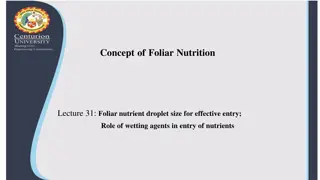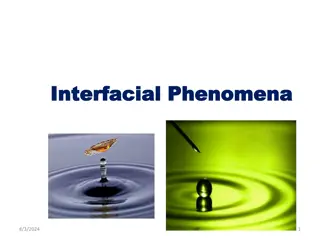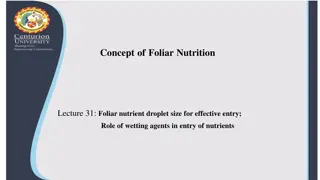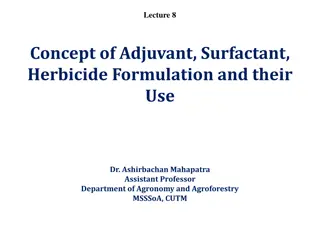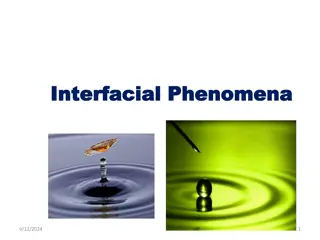Understanding Adjuvants and Herbicide Formulation in Agriculture
Adjuvants play a crucial role in enhancing the effectiveness of herbicides by aiding in wetting, spreading, and penetration of herbicides into target plants. Different types of adjuvants such as surfactants, stabilizing agents, coupling agents, humectants, and deposit builders serve specific functio
2 views • 10 slides
Concept of Foliar Nutrition
Explore the crucial concepts of foliar nutrition, including the role of droplet size in nutrient entry and the importance of wetting agents in optimizing nutrient absorption in plants. Discover how smaller droplets enhance efficiency while avoiding drift, and how wetting agents facilitate water upta
0 views • 8 slides
Statistical Modeling of Pore-Scale Intermittency and Ostwald Ripening
Using a statistical approach, this research delves into the pore-scale modeling of intermittency and Ostwald ripening in two-phase flows. The study challenges the traditional linear relationship between pressure gradient and capillary number, highlighting the impact of fluid intermittency on flow be
0 views • 15 slides
Common Casting Defects in Prosthodontics: Causes and Prevention
Casting defects in prosthodontics can result from errors in the casting procedure, leading to issues like distortion, surface roughness, porosity, and incomplete detail. Various causes such as stress relaxation during wax pattern preparation can contribute to distortion, while factors like air bubbl
5 views • 27 slides
A Comparison of Stonehenge and the Pyramids of Giza
The Egyptian pyramids, located in Egypt, were primarily built as tombs for pharaohs. Imhotep is credited with the method of stacking mastabas to create these impressive structures. Construction involved moving massive stone blocks using sleds and wetting sand to reduce friction. The pyramids were be
0 views • 9 slides
Understanding Interfacial Phenomena in Surfactant Solutions
Micelle formation is a key process in surfactant solutions, where the critical micelle concentration (CMC) is reached leading to the formation of micelles. The CMC decreases with longer hydrophobic chains and is influenced by the addition of electrolytes. Adsorption at solid interfaces and wetting p
1 views • 21 slides
Understanding Foliar Nutrition: Droplet Size and Wetting Agents
Foliar nutrition focuses on the effective entry of nutrients into plants through foliar applications. Key factors include droplet size for optimal absorption, the role of wetting agents in nutrient entry, and the importance of fertilizer materials with high solubility and purity. Smaller droplets en
0 views • 8 slides
Understanding Adjuvants and Herbicide Formulation
Adjuvants are additives that enhance herbicide effectiveness, crucial for optimal weed control. Types include surfactants, stabilizing agents, coupling agents, humectants, deposit builders, and more. Surfactants aid in wetting and spreading herbicides, stabilizing agents keep suspensions intact, cou
0 views • 10 slides
Feasibility of Alternate Wetting and Drying as a GHG Mitigation Option in Rice Fields
This synthesis study explores the site-specific feasibility of alternate wetting and drying (AWD) as a greenhouse gas mitigation option in irrigated rice fields in Southeast Asia. The research analyzes the impact of environmental and soil properties on GHG mitigation, evaluates trade-offs and co-ben
1 views • 19 slides
Best Practices for Camp Leaders: Ensuring Safety and Creating a Positive Environment
Discover essential guidelines for camp leaders to demonstrate God's love while prioritizing the safety and well-being of campers. Topics include safety protocols, code of conduct, handling bed-wetting incidents, addressing sleepwalking and night terrors, dealing with stealing, and the roles of camp
0 views • 21 slides
Understanding Interfacial Phenomena and Micelle Formation
Interfacial phenomena play a crucial role in the formation of micelles in surfactant solutions, leading to a decrease in surface tension. The critical micelle concentration (CMC) marks the point where micelles first form in the solution. Factors like chain length and electrolytes impact CMC and mice
0 views • 20 slides
Understanding Pipette Calibration Procedures and Criteria
Pipette calibration is essential for ensuring the accuracy and precision of volume measurements in laboratory settings. This process involves testing the maximum and minimum volumes, pre-wetting tips, and evaluating acceptance criteria for accuracy and precision. By following specific procedures suc
0 views • 8 slides
Understanding Behavioral Disorders in Children
Behavioral disorders in children can result from various factors like emotional, physical, and social deprivation. These disorders manifest through a range of behaviors such as temper tantrums, bed-wetting, and aggressiveness. Identifying the causes and types of behavioral disorders is essential for
0 views • 49 slides
Insights into Astrochemistry: Chemical Intuition and Surface Wetting
Discover the intriguing world of astrochemistry through the lens of Chemical Intuition and surface wetting phenomena. Dive into the experimental and computational laboratory perspectives, exploring the complexities of molecular interactions on polar surfaces like silica. Unravel the surprising behav
0 views • 17 slides
Importance of Hand Washing in Poultry and Egg Safety
Hand washing plays a crucial role in maintaining poultry and egg safety by preventing harmful bacteria like Salmonella and Campylobacter from spreading. Proper hand washing before and after handling food products, cracking eggs, using the bathroom, touching pets, and more is essential to prevent foo
0 views • 10 slides

